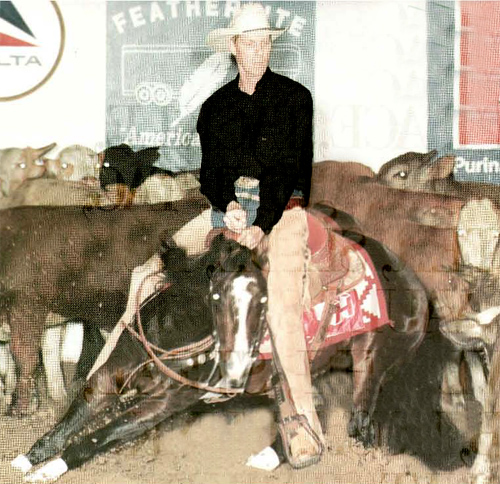Super Stakes History Spotlight

“He’s the first super star I’ve had in a long time,†said Tom Lyons, following his 223-point win aboard Smart Little Uno, in the 1992 NCHA Super Stakes. “Paul Hansma hit it right on the head when he said, if your horses have any holes in them, there were some cattle that would show up the holes.â€
Lyons and Hansma had watched as NCHA Futurity champion Little Tenina, shown by Greg Welch, and NCHA Futurity reserve champion Mr Peponita Flo, with John Tolbert, were eliminated in the first set of cattle with scores of 180 and 190 points, respectively. But Bowmans Fancy, shown by Paul Hansma for GCH Land & Cattle, held on for the reserve championship with 220.5 points, and Smart Little Uno and Lyons prevailed, as last to work in the 20-horse finals.
“I don’t think I was ever more excited than when I marked that twenty-three,†said Lyons, who had won the NCHA Super Stakes five years earlier with 227 points on Dry Clean, owned by Tom and Sue Ryan. The 1992 win was especially gratifying for 47-year-old Lyons, who bred Smart Little Uno and had won the 1973 NCHA Futurity, 1974 NCHA Derby, and the 1981 NCHA World championship riding the colt’s dam, Doc’s Marmoset.
Despite a rocky road prior to the NCHA Futurity, Lyons thought that Doc’s Marmoset’s Smart Little Lena son, Uno, was “as good a young horse†as he had ever ridden. While being treated for a respiratory infection during the summer of his 3-year-old year, Smart Little Uno foundered and had to forfeit three critical months of training to recover. Then during the first go-round of the Futurity, he developed a quarter crack in a front foot, but thanks to prompt treatment was able to continue to the finals, where he tied for eighth place.
Smart Little Uno was one of three 1988 Smart Little Lena embryo transfer foals produced out of Doc’s Marmoset. According to AQHA rules at the time, only one foal could be registered out of a mare each year, and Doc’s Marmoset first born, Smart Little Uno, was the one chosen for registration. As the siblings matured, Smart Little Uno, Smart Little Dos, and Smart Little Tres all differed in appearance and style, according to Lyons, but Uno was the prettiest and seemed to have inherited the best working qualities of his sire and dam.
“Uno doesn’t have the strength that the old mare (Doc’s Marmoset) had,†he said. “But he’s that kind of stopper, and he has Smart Little Lena’s quickness.
Lyons began training cutting horses in 1972 and went straight to the top with his win in the 1973 NCHA Derby on Doc’s Lynx, followed by the 1973 NCHA Futurity win and 1974 Derby win on Doc’s Marmoset. Building on a spectacular decade, in 1976 he placed fourth in the NCHA Futurity with Doc’s Marmoset’s full brother, Doc’s Oak, who would become a leading sire with offspring earnings of $8.8 million; in 1980 he won the NCHA world championship and World Finals on Doc N Willy, by Doc’s Lynx and the 1980 NRCHA Snaffle Bit Futurity with Docs Baroque, by Doc’s Oak; then capped the following year, showing Doc’s Marmoset as the 1981 NCHA World champion.
“Oak and Marmoset were out of Susie’s Bay, and she was a big, stout-hipped mare,†Lyons noted. “They always said that Oak was the best stopping Doc Bar there ever was, and Marmoset was probably one of the best stopping mares.â€
Smart Little Uno earned $104,554 and was retired at the end of his 4-year-old year to stand at Winridge Farm in Cleburne, Texas. He was later purchased by Strawn Valley Ranch, Strawn Texas, and sired 115 earners of $1.9 million, including Uno Palomino LTE $231,499, shown as 1999 NCHA Super Stakes and Derby Non-Pro reserve champion by Debbie Patterson.
Lyons, an NCHA Hall of Fame Rider and NCHA Member’s Hall of Fame inductee and past Association president, is ranked among cutting’s to 25 money earners with $2.7 million.
